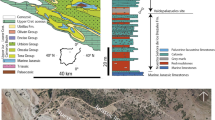Abstract
SINCE the discovery of the tooth Morganucodon uatsoni in a fissure at the Duchy Quarry near Bridgend, Glamorgan, which yields a Rhaeto-Liassic mammalian fauna, about fifty teeth or fragments of teeth have been found. With few exceptions the fauna consists of ‘Triconodonts’, identical with those collected by Prof. B. Peyer from Upper Rhaetic bone-bed material at Hallau near Schaffhausen. The only members of the fauna which are adequate for comparison with other material are the ‘Triconodonts’. I wish to emphasize that all the known facts having a bearing on the geological age of the Morganucodon fissure are consistent with a Rhaeto-Liassic age.
Similar content being viewed by others
References
Kühne, W. G., Proc. Zool. Soc. Lond., 119, Pt. II, 345 (1948).
Simpson, G. G., Amer. J. Sci., 87 (Aug. 1926).
Author information
Authors and Affiliations
Rights and permissions
About this article
Cite this article
KÜHNE, W. A Symmetrodont Tooth from the Rhaeto-Lias. Nature 166, 696–697 (1950). https://doi.org/10.1038/166696a0
Issue Date:
DOI: https://doi.org/10.1038/166696a0
- Springer Nature Limited
This article is cited by
-
The Kuehneotheriidae (Mammaliaformes) from Saint-Nicolas-de-Port (Upper Triassic, France): a Systematic Review
Journal of Mammalian Evolution (2017)
-
Rhaetische Triconodonten aus Glamorgan, ihre Stellung zwischen den Klassen Reptilia und Mammalia und ihre Bedeutung für die REICHART'sche Theorie
Paläontologische Zeitschrift (1958)





